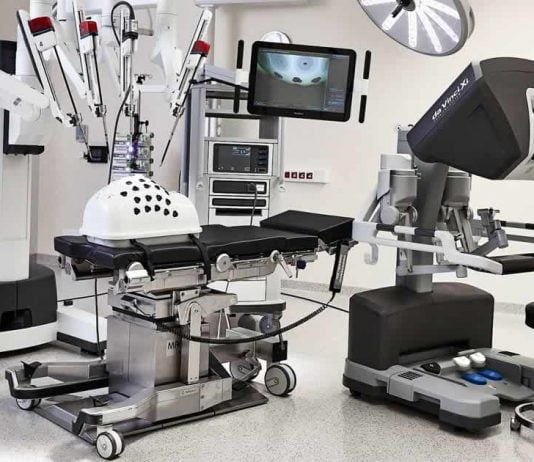Machine learning has become one of the main tech trends in software engineering in recent years. Thus, Nature magazine claims that along with the existing solutions for smart diagnostics, ML will soon help propel the invention of new drugs, saving tens of millions of dollars to the state and pharmaceutical companies.
Let’s dive a bit deeper into the topic and learn how exactly machine learning practices exactly help modern medical experts.
Getting Closer to the Human Mind Principles with Neural Networks: The Origins of Machine Learning
Neural networks are focused on an effort to recreate a simplified model of the nervous systems in biological organisms. In living things, a neuron is an electrically excitable cell that processes, stores, and transmits information using electrical and chemical signals through synaptic connections. The neuron has a complex structure and narrow specialization. By connecting to each other to transmit signals through synapses, neurons create biological neural networks.
In turn, the ability of biological nervous systems to learn from their mistakes forms the basis for the idea to create artificial neural networks. As a result, one of the original approaches was the concept of an artificial neuron – a mathematical function that converts several input facts into one output, assigning the respective values.
Top 5 ML-Based Healthcare Solutions
Which particular innovations help advance regular medical practices to the new level of efficiency and power? Let’s take a look at the major solutions in different fields of healthcare.
Surgical practice
One of the most ambitious developments in machine learning in the field of surgical medicine can be considered the four-armed da Vinci robot. In addition to the support of manual controls for the live surgeon, this machine is also capable of operating independently, based on previously acquired knowledge.
The da Vinci design includes one camera-equipped arm. The camera features a powerful 360-degree zoom. Apart from that, the robot has three more motorized arms based on electric drives, which are used both for trivial operations and for eliminating malignant neoplasms that cannot be reached manually. We are talking, first of all, about tumors in the brain, as well as all kinds of artifacts in intestinal cavities.
Cancer chances calculation
The popular web resource Science Direct published an article that details aspects of predicting diseases using machine learning and, in particular, considers the problem of calculating the risks of cancer.
For instance, there are networking algorithms such as Artificial Neural Networks (ANNs), Bayesian Networks (BNs), Support Vector Machines (SVMs), and Decision Trees (DTs), which, as part of the carrier software, are able to independently predict cancerous tumors and cell mutations. That is, even when the treatment should be carried out only as a part of preventive measures.
In the future, these developments promise the unthinkable – humanity can completely cope with a number of incurable diseases through a preliminary diagnosis.
Diagnostics of difficult to define diseases
IBM’s Watson Health platform has been used in renowned radiology centers around the world for years. It is already capable of diagnosing cancer, heart problems, and all kinds of diseases associated with diabetes in a matter of seconds.
American IT scientists’ colleagues from Google work on innovations in a similar direction as well. For example, DeepMind Health software is used by one of the largest ophthalmological clinics in Britain, determining the most complex diseases and pathologies of the eye. With the help of machine learning methods, it is possible to recognize, designate, and calculate almost any pathological signs of diseases by analyzing medical images, clinical and laboratory data.
Automated patient service
The well-known company Roche is looking to implement the most high-tech developments not only at the level of discovering new medicines and medical devices but also at the level of patient service. Thus, machine learning is actively used by medical centers partnering with the company. This is done in order to avoid drawing up incorrect medical prescriptions for patients.
Many modern treatment centers focus on regular patient care workflow based on end-to-end automation. Machine learning, in turn, helps in diagnosis, as it takes into account all the details of the patient’s history.
Innovations in meds
As we already know, machine learning is an excellent tool for the development of new drugs. The above-mentioned pharmaceutical giant Roche is looking to use machine learning and artificial intelligence applications to create more targeted treatments. This can be considered a revolutionary development since modern drugs still cause a bunch of side effects.
The Atomwise startup has been using machine learning to develop new meds since 2012. Every day, the startup software tests about 10 million chemical compounds, determining their effect on diseases and pathologies.
Note that all these developments are still of a purely theoretical nature since in order to launch a new drug on the market, it is necessary to conduct long-term clinical trials in focus groups with live people. Nevertheless, even today, Atomwise can be used for the production of generics (however, new drugs have to be patented first to be launched on the market).
Conclusion
As you can see, smart systems are capable of making a real breakthrough in the field of medicine as well as in many other industries. There are also many more technological niches focused on software/hardware-driven decision making. Learn more about advanced technologies and their specifics.
